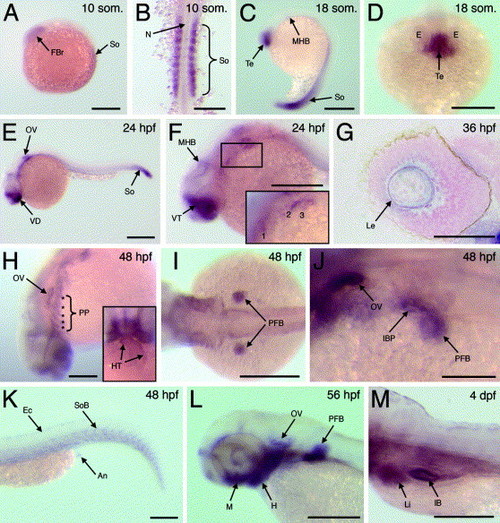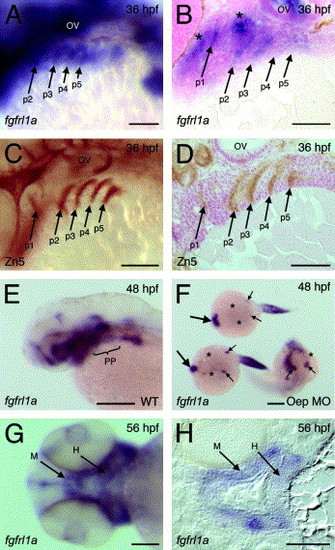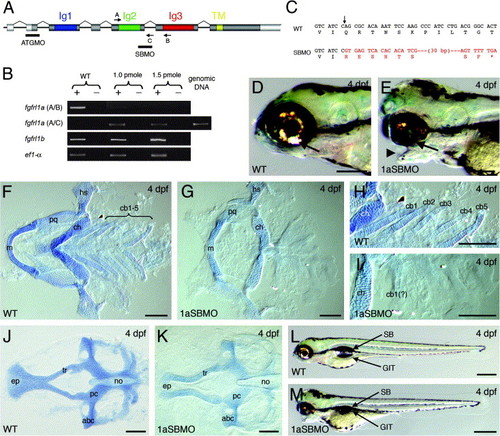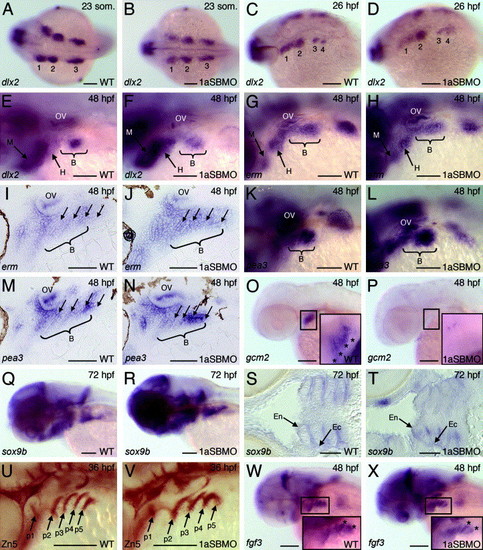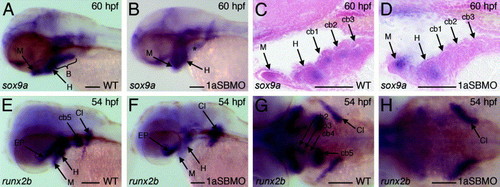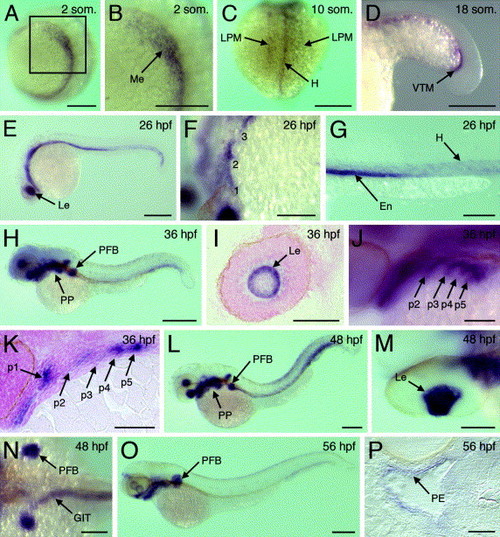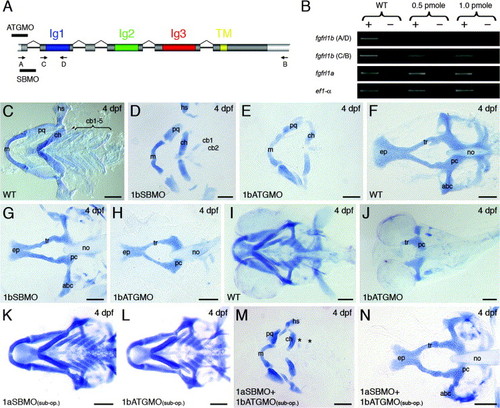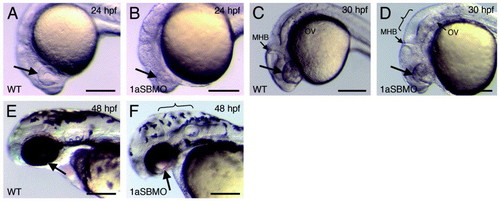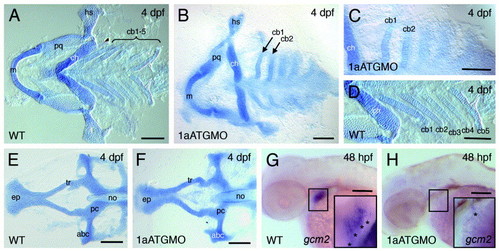- Title
-
An essential role for zebrafish Fgfrl1 during gill cartilage development
- Authors
- Hall, C., Flores, M.V., Murison, G., Crosier, K., and Crosier, P.
- Source
- Full text @ Mech. Dev.
|
Expression of fgfrl1a during zebrafish development. (A) Lateral view of 10 somite stage embryo. (B) Flat mount of 10 somite stage embryo. (C) Lateral view of 18 somite stage embryo. (D) Higher magnification of forebrain region at 18 somite stage. (E) Lateral view of 24 hpf embryo. (F) Higher magnification of cranio-trunk region at 24 hpf; inset represents enlarged view of boxed region. Pharyngeal pouches marked as 1, 2 and 3. (G) Section through eye at 36 hpf. (H) Dorsolateral view of head region of 48 hpf embryo; asterisks mark pharyngeal pouches, inset represents frontal view of head region. (I) Dorsal view of anterior trunk region of 48 hpf embryo. (J) Dorsolateral view of anterior trunk at 48 hpf. (K) Lateral view of tail region of 48 hpf embryo. (L) Lateral view of head region at 56 hpf. (M) Lateral view of anterior trunk at 4 dpf. Abbreviations: An, anus; E, eye; Ec, ectoderm; FBr, forebrain; H, hyoid arch; HT, heart tube; IB, intestinal bulb; IBP, intestinal bulb primordium; Le, lens; Li, liver; M, mandibular arch; MHB, midbrain–hindbrain boundary; N, notochord; OV, otic vesicle; PFB, pectoral fin bud; PP, pharyngeal pouches; So, somites; SoB, somite boundaries; Te, telencephalon; VD, ventral diencephalon; VT, ventral telencephalon. Scale bars: 250 μm in A–F, H, I and K–M; 100 μm in G and J. EXPRESSION / LABELING:
|
|
Pharyngeal arch expression of fgfrl1a. (A and B) Lateral view of fgfrl1a expression within pharyngeal region of 36 hpf embryo and equivalent sagittal section, respectively. Asterisks mark expression within arch 1- and 2-associated neural crest. (C and D) Lateral view of pharyngeal region of Zn5-stained embryo and equivalent sagittal section, respectively. (E) Lateral view of fgfrl1a expression within head of 48 hpf embryo. (F) Expression of fgfrl1a in 48 hpf embryos following morpholino-mediated depletion of Oep (two embryos to left phenocopy maternal-zygotic Oep mutants while the embryo on the right a less severe, zygotic, Oep mutant). Large and small arrows denote persistence of fgfrl1a transcript in anterior domains and otic vesicles, respectively. Asterisks highlight absence of expression in pharyngeal pouch endoderm. (G and H) Ventral view of head region at 56 hpf and equivalent frontal section, respectively. Abbreviations: H, hyoid arch; M, mandibular arch; OV, otic vesicle; p1–5, pharyngeal pouch 1–5; PP, pharyngeal pouches. Scale bars: 100 μm in A–D, G and H; 250 μm in E and F. |
|
Targeted depletion of Fgfrl1a results in specific defects within the pharyngeal cartilage. (A) Genomic organization of fgfrl1a illustrating the Ig-like (Ig1, 2 and 3) and transmembrane (TM) domains, and the target site for the splice-blocking (SBMO) and ATG (ATGMO) morpholinos. ORF and untranslated regions highlighted by dark and light shading, respectively. The location and orientation of primers used for RT-PCR detection of altered splicing are indicated by arrows. (B) Semi-quantitative RT-PCR illustrating specific depletion of normal fgfrl1a splicing following early delivery of 1.0 and 1.5 pmol doses of SBMO (+, reverse transcriptase present; -, reverse transcriptase absent). Primer combinations are bracketed. (C) Predicted translation of fgfrl1a following SBMO-mediated defective splicing. Arrow denotes splice site between Ig2- and Ig3-encoding exons. Black and red text corresponds to coding and intronic sequence, respectively. (D, F, H, J and L) 4 dpf wildtype embryos. (E, G, I, K and M) 4 dpf Fgfrl1a morphant embryos. (D/E) lateral views. (F–K) Dissected and flat-mounted cartilaginous elements stained with alcian blue. (F/H and G/I) Ventral cartilage elements from wildtype and Fgfrl1a morphant larvae, respectively. (J and K) Neurocranium from wildtype and Fgfrl1a morphant larvae, respectively. Arrowhead marks dysmorphic jaw. Abbreviations: abc, anterior basicranial commissure; cb1–5, ceratobranchial arch 1–5; cb1(?), presumptive remnants of ceratobranchial element 1; ch, ceratohyal; ep, ethmoid plate; GIT, gastrointestinal tract; hs, hyosymplectic; m, Meckel’s cartilage; no, notochord; pc, parachordal; pq, palatoquadrate; SB, swim bladder; tr, trabecula. Scale bars: 250 μm in D and E; 100 μm in F–K; 500 μm in L and M. PHENOTYPE:
|
|
Fgfrl1a is essential for gcm2 expression within the pharyngeal epithelium. (A, C and E) Neural crest expression of dlx2 in 23 somite (dorsal view), 26 hpf (dorsolateral view) and 48 hpf (lateral view) wildtype embryos, respectively. (B, D and F) dlx2 expression in 23 somite, 26 hpf and 48 hpf Fgfrl1a morphant embryos, respectively. Neural crest streams are numbered. (G/I and H/J) Lateral views of erm expression within pharyngeal domain of 48 hpf wildtype and Fgfrl1a morphant embryos, respectively. (G/H and I/J) Lateral views and equivalent sagittal sections, respectively. Arrows mark pharyngeal pouches within branchial domain. (K/M and L/N) Lateral views of pea3 expression within pharyngeal domain of 48 hpf wildtype and Fgfrl1a morphant embryos, respectively. (K/L and M/N) Lateral views and equivalent sagittal sections, respectively. Arrows mark pharyngeal pouches within branchial domain. (O and P) Lateral views of gcm2 expression within pharyngeal domain of 48 hpf wildtype and Fgfrl1a morphant embryos, respectively. Inset represents enlarged views of boxed regions. Asterisks mark branchial arches. (Q/S and R/T) sox9b expression within pharyngeal domain of 72 hpf wildtype and Fgfrl1a morphant larvae, respectively. (Q/R and S/T) Lateral views and equivalent frontal sections, respectively. (U and V) Lateral views of Zn5-stained pharyngeal pouch endoderm within 36 hpf wildtype and Fgfrl1a morphant embryos, respectively. (W and X) Lateral views of fgf3 expression within pharyngeal domain of 48 hpf wildtype and Fgfrl1a morphant embryos, respectively. Inset represents enlarged views of boxed regions. Asterisks mark pharyngeal pouches. Abbreviations: B, branchial arches; Ec, pharyngeal ectoderm; En, pharyngeal endoderm; H, hyoid arch; M, mandibular arch; OV, otic vesicle; p1–5, pharyngeal pouches 1–5. Scale bars: 100 μm in A–X. EXPRESSION / LABELING:
|
|
Fgfrl1a is essential for chondrogenesis within the ceratobranchial arches. (A/C and B/D) sox9a expression within pharyngeal domain of 60 hpf wildtype and Fgfrl1a morphant larvae, respectively. (A/B and C/D) Lateral views and equivalent sagittal sections, respectively. Asterisk in B marks absence of expression within branchial arches. (E/G and F/H) runx2b expression within pharyngeal region of 54 hpf wildtype and Fgfrl1a morphant larvae, respectively. (E/F and G/H) Lateral and dorsal views, respectively. Abbreviations: B, branchial arches; cb1–5, ceratobranchial arches 1–5; Cl, cleithrum; EP, ethmoid plate; H, hyoid arch; M, mandibular arch. Scale bars: 100 μm in A–H. |
|
Expression of fgfrl1b during zebrafish development. (A) Dorsolateral view of 2 somite stage embryo. (B) Higher magnification of boxed region in A. (C) Dorsal view of posterior domain in 10 somite stage embryo. (D) Lateral view of developing tail in 18 somite stage embryo. (E) Lateral view of 26 hpf embryo. (F) Dorsolateral view of midbrain–hindbrain region of 26 hpf embryo. Pharyngeal pouches labelled as 1, 2 and 3. (G) Lateral view of trunk of 26 hpf embryo. (H) Lateral view of 36 hpf embryo. (I) Sagittal section through eye of 36 hpf embryo. (J) Lateral view of pharyngeal region of 36 hpf embryo. (K) Sagittal section through pharyngeal region of 36 hpf embryo. (L) Lateral view of 48 hpf embryo. (M) Dorsal view of eye of 48 hpf embryo. (N) Dorsal view of cranio-trunk region of 48 hpf embryo. (O) Lateral view of 56 hpf larva. (P) Frontal section through developing jaw of 56 hpf larva. Abbreviations: En, endoderm; GIT, gastrointestinal tract; H, hypochord; Le, lens; LPM, lateral plate mesoderm; Me, mesendoderm; p1–5, pharyngeal pouches 1–5; PE, pharyngeal endoderm; PFB, pectoral fin bud; PP, pharyngeal pouches; VTM, ventral tail mesenchyme. Scale bars: 250 μm in A, D, H and K; 100 μm in B, C, E–G, I, J, L and M. EXPRESSION / LABELING:
|
|
Fgfrl1b is necessary for proper chondrogenesis of all ventral cartilage elements. (A) Genomic organization of fgfrl1b illustrating the Ig-like (Ig1, 2 and 3) and transmembrane (TM) domains, and the target site for the splice-blocking (SBMO) and ATG-targeting (ATGMO) morpholinos. ORF and untranslated regions highlighted by dark and light shading, respectively. The location and orientation of primers used for RT-PCR detection of altered splicing are indicated by arrows. (B) Semi-quantitative RT-PCR illustrating specific depletion of normal fgfrl1b splicing following early delivery of 0.5 and 1.0 pmol doses of SBMO (+, reverse transcriptase present; -, reverse transcriptase absent). Primer combinations are bracketed. (C–N) 4 dpf larvae stained with alcian blue. (C, D and E) Dissected ventral cartilage elements from wildtype, 1bSBMO-injected and 1bATGMO-injected larvae. (F, G and H) Dissected cranial cartilage elements from wildtype, 1bSBMO-injected and 1bATGMO-injected larvae. (I and J) Dorsal view of cartilage elements of wildtype and 1bATGMO-injected larvae presenting severe phenotype. (K and L) Dorsal view of larvae injected with sub-optimal doses of either 1aSBMO or 1bATGMO exhibiting normal chondrogenesis. (M and N) Dissected ventral and cranial cartilage elements from larvae treated with a combination of sub-optimal doses of 1aSBMO and 1bATGMO displaying absence or reduction of ceratobranchial cartilage. Abbreviations: abc, anterior basicranial commissure; cb1–5, ceratobranchial arch 1–5; ch, ceratohyal; ep, ethmoid plate; hs, hyosymplectic; m, Meckel’s cartilage; no, notochord; pc, parachordal; pq, palatoquadrate; tr, trabecula. Scale bars: 100 μm. PHENOTYPE:
|
|
Depletion of Fgfrl1a results in specific developmental defects. (A, C, and E) 24, 30 and 48 hpf wildtype embryos, respectively. (B, D and F) 24, 30 and 48 hpf Fgfrl1a morphant embryos, respectively (lateral views). Arrows mark developing eye. Braces mark expanded hindbrain region. Abbreviations: MHB, midbrain–hindbrain boundary; OV, otic vesicle. Scale bars: 250 μm. |
|
Cartilage defects and absence of ectodermal gcm2 expression in 1aATGMO-injected animals. (A, D, E and G) Wildtype animals. (B, C, F and H) 1aATGMO-injected animals. (A and B) Dissected ventral cartilage elements stained with alcian blue at 4 dpf. (C and D) Ceratobranchial cartilage elements stained with aclian blue at 4 dpf. (E and F) Dissected neurocranium from alcian blue-stained 4 dpf larvae. (G and H) Lateral views of gcm2 expression within pharyngeal domain at 48 hpf. Inserts represent enlarged views of boxed regions. Asterisks mark gcm2 expression within ectodermal lining of branchial arches. Asterisk in H marks persistent gcm2 expression within 1aATGMO-injected embryo. Abbreviations: abc, anterior basicranial commissure; cb1–5, ceratobranchial arch 1–5; ch, ceratohyal; ep, ethmoid plate; hs, hyosymplectic; m, Meckel’s cartilage; no, notochord; pc, parachordal; pq, palatoquadrate; tr, trabecula. Scale bars: 100 μm. PHENOTYPE:
|

Unillustrated author statements EXPRESSION / LABELING:
|
Reprinted from Mechanisms of Development, 123(12), Hall, C., Flores, M.V., Murison, G., Crosier, K., and Crosier, P., An essential role for zebrafish Fgfrl1 during gill cartilage development, 925-940, Copyright (2006) with permission from Elsevier. Full text @ Mech. Dev.

